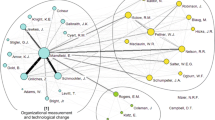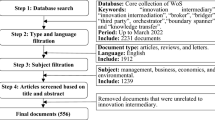Abstract
This paper is an investigation of the knowledge sources of Korean innovation studies using citation analysis, based on a Korean database during 1993–2004. About two thirds of knowledge has come from foreign sources and 94% of them are from English materials. Research Policy is the most frequently cited journal followed by Harvard Business Review, R&D Management and American Economic Review. An analysis of who cites the most highly cited journal is also included. Neo-Schumpeterians in Korea cite more papers from Research Policy than general researchers, and there is no difference between groups in the year of citation.
Similar content being viewed by others
References
Abt, H. A. (2000), Do important papers produce high citation counts? Scientometrics, 48(1): 65–70.
Ahmed, T., Johnson, B., Oppenheim, C., Peck, C. (2004), Highly cited old papers and the reasons why they continue to be cited. Part II — The 1953 Watson and Crick article on the structure of DNA, Scientometrics, 61(2): 147–156.
Aksnes, D. W. (2003), A macro study of self-citation, Scientometrics, 56(2): 235–246.
Aksnes, D. W., Sivertsen, G. (2004), The effect of highly cited papers on national citation indicators, Scientometrics, 59(2): 213–224.
Arrow, K. J. (1962), Economic welfare and the allocation of resources for invention, In: Lamberton, D. M. (Ed.), The Rate and Direction of Inventive Activity, Baltimore: Penguin Books, Ltd.
Arrow, K. J. (1962), The economic implications of learning by doing, Review of Economic Studies, 29: 155–173.
Bart, V., Werker, C. (2004), Keith Pavitt and the Invisible College of the Economics of Technology and Innovation, Research Policy, 33(9): 1419–1431.
Biehl, M., Kim, H., Wade, M. (2006), Relationships among the academic business disciplines: A multimethod citation analysis, Omega, 34(4): 359–371.
Callon, M., Coenen, R., Cohen, W. H., Freeman, C., Kodama, F., Meyerkrahmer, F., Pavitt, K., Pisano, G. P. (1999), Retrospective evaluation (1971–1999), Research Policy, 28: 911–919.
Cheng, C. H., Kumar, A., Motwani, J. G., Reisman, A., Madan, M. S. (1999), A citation analysis of the technology innovation management journals, IEEE Transactions on Engineering Management, 46(1): 4–13.
Cronin, B. (1984), The Citation Process: The Role and Significance of Citations in Scientific Communication, Taylor Graham, London.
Dopfer, K. (1994), The phenomenon of economic change: Neoclassical versus Neoschumpeterian approaches, In: L. Magnusson (Ed.), Evolutionary and Neoschumpeterian Approaches, Boston/Dordrecht/London: Kluwer Academic Publishers, pp. 125–171.
Dosi, G. (1988), Sources, Procedures, and Microeconomic Effects of Innovation, Journal of Economic Literature, 26(3): 1120–1171.
Doyle, M. W., Julian, J. P. (2005), The most-cited works in geomorphology, Geomorphology, 72: 238–249.
Dunford, M., Perrons, D., Reilly, B., Bull, R. (2002), Citations, authors and referees — Regional Studies, 1981–2002, Regional Studies, 36(9): 1053–1065.
Echeverria-Carrol, E. L. (1999), Knowledge flows in innovation networks: A comparative analysis of Japanese and US high-technology firms, Journal of Knowledge Management, 3(4): 296–303.
Eto, H. (2002), Authorship and citation patterns in management science in comparison with operational research, Scientometrics, 53(3): 337–349.
Foss, N. J., Pedersen T. (2002), Transferring knowledge in MNCs: The role of sources of subsidiary knowledge and organizational context, Journal of International Management, 8(1): 49–67.
Garfield, E. (1955), Citation indexes for science: A new dimension in documentation through association of ideas, Science, 22: 108–111.
Garfield, E. (1979), Citation Indexing: Its Theory and Application in science, Technology, and Humanities, Wiley, New York.
Glänzel, W., Thijs, B. (2004a), The influence of author self-citations on bibliometric macro indicators, Scientometrics, 59(3): 281–310.
Glänzel, W., Thijs, B. (2004b), Does co-authorship inflate the share of self-citations?, Scientometrics, 61(3): 395–404.
Glänzel, W., Thijs, B., Schlemmer, B. (2004), A bibliometric approach to the role of author self-citations in scientific communication, Scientometrics, 59(1): 63–77.
Godin, B. (1998), Measuring knowledge flows between countries: The use of scientific meeting data, Scientometrics, 42(3): 313–323.
Gupta, A. K., Govindarajan, V. (2000), Knowledge flows within multinational corporations, Strategic Management Journal, 21(4): 473–496.
Harter, S., Kim, H. (1996), Electronic journals and scholarly communication: A citation and reference study, Proceedings of the ASIS Midyear Meeting, San Diego, CA., pp. 299–315.
Hong, S. K., Hong, S. G., Ahn, D. (1991), A Study on Intersectoral Flow and Productivity Increasing Effects of R&D, Policy Research 91–14, Science and Technology Policy Institute, Seoul. (Korean).
Huh, E. N. (2000), Review of valuation methods — CVM, MAUA and Real Option Pricing, The Journal of Korea Technology Innovation Society, 3(1): 37–54. (Korean).
Kim, L. (1999), Building technological capability for industrialization: analytical frameworks and Korea’s experience, Industrial and Corporate Change, 8(1): 111–136.
Kim, M. J. (2001), A bibliometric analysis of physics publications in Korea, 1994–1998, Scientometrics, 50(3): 503–521.
Kim, M. J. (2002), Citation patterns of Korean physicists and mechanical engineers: differences by type of publication source and type of authorship, Scientometrics, 55(3): 421–436.
Kleinberg, J. (1999), Authoritative sources in a hyperlinked environment, Journal of the ACM, 46(5): 604–632.
Kostoff, R. N. (2002), Citation analysis of research performer quality, Scientometrics, 53(1): 49–71.
Lange, L. L. (2001), Citation counts of multi-authored papers: First-named authors and further authors, Scientometrics, 52(3): 457–470.
Lee, J., Bae, Z., Choi, D. (1988), Technology development process: A model for developing country with a global perspective, R&D Management, 18(3): 235–250.
Lee, K. R. (1996). The role of user firms in the innovation of machine tools: The Japanese case. Research Policy, 25(5): 491–507.
Lee, K. R. & al. (1998), Korean National Innovation System, Science and Technology Policy Institute, Seoul.
Leimu, R., Koricheva, J. (2005), What determines the citation frequency of ecological papers, Trends in Ecology & Evolution, 20(1): 28–32.
Li, J., Tsui, A. S. (2002), A citation analysis of management and organization research in the Chinese context: 1984–1999, Asia Pacific Journal of Management, 19(1): 87–107.
Lim, Y. T., Song, C. H. (1996), An international comparative study of basic scientific research capacity: OECD Countries, Taiwan and Korea, Technological Forecasting and Social Change, 52(1): 75–94.
Linton, J. D., Thongpapanl, N. (2004), Perspective: ranking the technology innovation management journals, The Journal of Product Innovation Management, 21(2), 123–139.
Ma, C., Stern, D. (2006), Environmental and ecological economics: A citation analysis, Ecological Economics, 58(3): 491–506.
Merino, T. G., Carmo, L. P. D., Alvarez, V. S. (2006), 25 years of Technovation: characterization and evolution of the journal, Technovation, 26(12): 1303–1316.
Meyer, M. (2000), Tracing knowledge flows in innovation systems, Scientometrics, 54(2): 193–212.
Mudambi, R., Navarra, P. (2004), Is knowledge power? Knowledge flows, subsidiary power and rent-seeking within MNCs. Journal of International Business Studies, 35(5): 385–406.
Namn, S. H., Park, J. M., Seol, S. S. (2005), Quantitative analysis of knowledge flow — technology innovation research in Korea, The Journal of Korea Technology Innovation Society, 8 (Special Edition): 337–359. (Korean).
Narin, F. (1976), Evaluative Bibliometrics: The Use of Publication and Citation Analysis in the Evaluation of Scientific Activity, Computer Horizons, Inc, Cherry Hill, New Jersey.
Nicolaisen, J. (2002), The J-shaped distribution of citedness, Journal of Documentation, 58(4): 383–395.
Nissen, M. E. (2005–2006), Dynamic knowledge patterns to inform design: A field study of knowledge stocks and flows in an extreme organization, Journal of Management Information Systems, 22(3): 225–263.
Norris, M., Oppenheim, C. (2003), Citation counts and the research assessment exercise V: Archaeology and the 2001 RAE, Journal of Documentation, 59(6): 709–730.
Paci, R., Batteta, E. (2003), Innovation Networks and Knowledge Flows across the European Regions, Working Paper, CRENoS 200313, Centre for North South Economic Research, University of Cagliari and Sassari, Sardinia.
Sandstrom, A., Pettersson, I., Nilsson, A. (2000), Knowledge production and knowledge flows in the Swedish biotechnology innovation system, Scientometrics, 48(2): 179–201.
Seol, S. S. (2000), An analytical framework for the valuation of technology, The Journal of Korea Technology Innovation Society, 3(1): 5–21. (Korean).
Seol, S. S., Namn, S. H. (2006), Innovation studies in Korea: origins, branches and activities, Paper presented at the 1st China-Korea International Conference on Innovation Studies, 11.3, Korea Technology Innovation Society, China Techno-Economics Society, Jeju Island, Korea.
Seol, S. S. & al. (1997), Innovation and Industrial, Science and Technology Policy, Industrial Technology Research Institute Press, Seoul. (Korean).
Smith, L. C. (1981), Citation analysis. Library Trends, 30: 83–106.
Solow, R. (1957), Technical change and the aggregate production function, Review of Economics and Statistics, 39: 312–320.
Song, C. H. (2003), Interdisciplinarity and knowledge inflow/outflow structure among science and engineering research in Korea, Scientometrics, 58(1): 129–141.
Spencer, J. W. (2000), Knowledge flows in the global innovation system: Do U.S. firms share more scientific knowledge than their Japanese rivals? Journal of International Business Studies, 31(3): 521–530.
Tahai, A., Meyer, M. J. (1999), A revealed preference study of management journals’ direct influence, Strategic Management Journal, 20(3): 279–296.
Wohlin, C. (2005), An analysis of the most cited articles in software engineering journals — 1999, Information and Software Technology, 47(15): 957–964.
Yong, F., Rousseau, R. (2001), Lattices in citation networks: An investigation into the structure of citation graphs, Scientometrics, 50(2): 273–287.
Zhu, X., Wu, Q., Zheng, Y., Ma, X., Zhu, X. (2004), Highly cited research papers and the evaluation of a research university: A case study: Peking University 1974–2003, Scientometrics, 60(2): 237–347.
Author information
Authors and Affiliations
Corresponding author
Rights and permissions
About this article
Cite this article
Seol, SS., Park, JM. Knowledge sources of innovation studies in Korea: A citation analysis. Scientometrics 75, 3–20 (2008). https://doi.org/10.1007/s11192-007-1826-5
Received:
Published:
Issue Date:
DOI: https://doi.org/10.1007/s11192-007-1826-5




